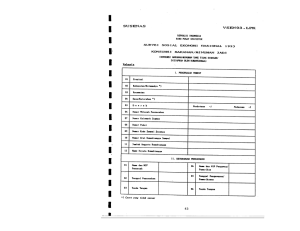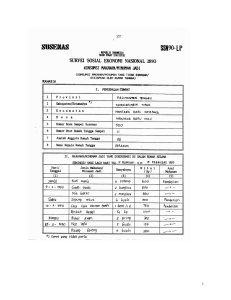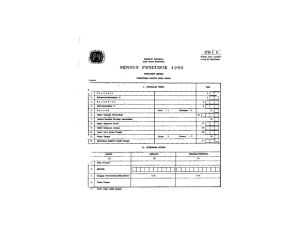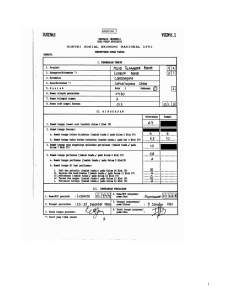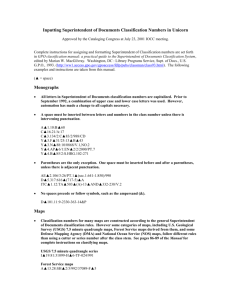NATIONAL SOCIO-ECONOMIC SURVEY 1994
advertisement
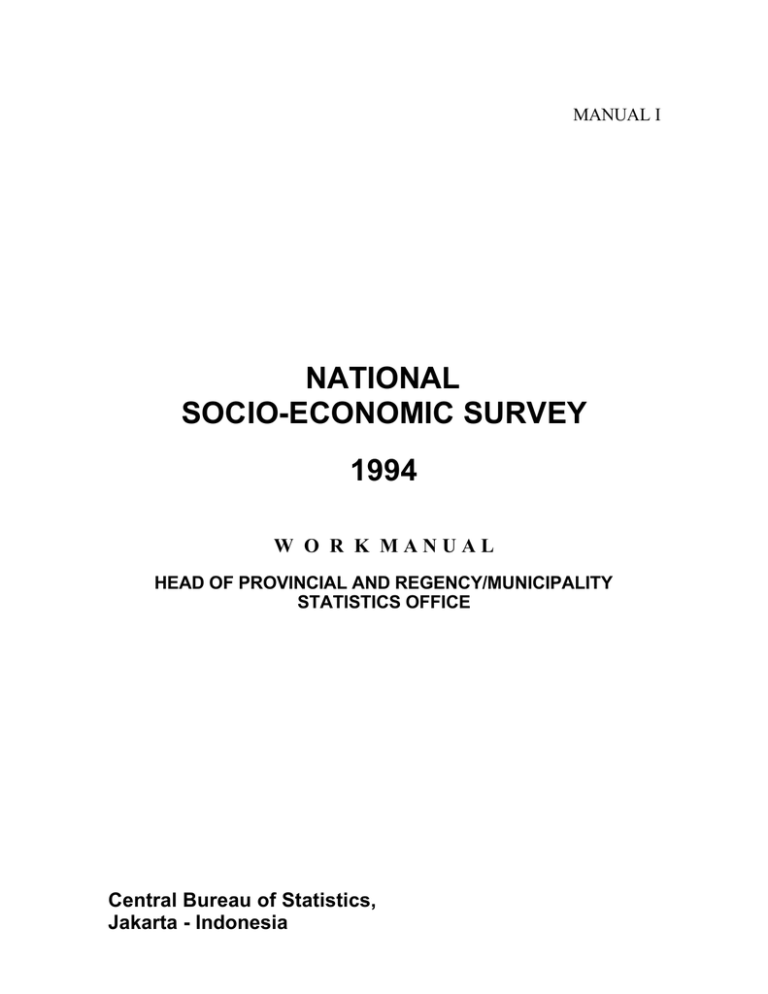
MANUAL I NATIONAL SOCIO-ECONOMIC SURVEY 1994 W O R K MANUAL HEAD OF PROVINCIAL AND REGENCY/MUNICIPALITY STATISTICS OFFICE Central Bureau of Statistics, Jakarta - Indonesia 2 C O N T E N T S I. PREFACE A. B. C. D. E. F. II. METHODOLOGY A. B. C. D. E. F. G. H. I. III. General Objectives Scope Schedule of Activities Statistics Compiled Information on Types of Data Collected Sample Outline Sample Design Formation and Selecting Segment Groups Susenas 1994 Selected Enumeration Areas Estimation Method Data Collection Method Data Processing Time Reference of Survey Type of Lists and Documents Used FIELD ORGANIZATION A. B. C. D. E. F. G. Implementation of the Survey at Local Areas Field Officers Training Schedule of Training Sending the Documents Requirements to Become a National Instructor Field Implementation ATTACHMENTS Attachment 1: Allocation of Enumeration Area Samples/ Segment Groups and Households Susenas 1994 Attachment 2: Allocation of Enumeration Area Samples/ Segment Groups and Core Households Susenas 1994 Attachment 3: Allocation of Enumeration Area Samples/ Segment Groups and Core-Module Households Susenas 1994 Attachment 4: Target Samples of Criminal Household, Traveling and Social Cultural Susenas 1994 Attachment 5: Number of Susenas 1994 Officers Attachment 6: Number of Classes and National Instructors Candidates Susenas 1994 Attachment 7: Example on List of Selected Enumeration Areas Susenas 1994 Attachment 8: Lists of Susenas 1994 1. VSEN94.L 2. VSEN94.DSRT 3. VSEN94.K 4. VSEN94.MK 5. VSEN94.MJ 6. VSEN94.MS Attachment 9: Table of Random Numbers 3 I. PREFACE A. General In order to implement their tasks, the Central Bureau of Statistics is responsible to provide data needed for planning sectional and cross sectional development. To observe the situation, monitor and evaluate the implementation of the development program, the availability of continuos data is very helpful in making necessary improvements of an existing program. The needs for social data specifically on the community welfare has to be fulfilled in order to understand whether the development outcome has reached the community of all levels mainly on the aspects of daily requirements such as needs for clothing, housing, education, health, security and work opportunity. The social data produced by BPS were gathered through various modes such as: Sensus Penduduk (SP), Survei Penduduk Antar Sensus (Supas), Survei Angkatan Kerja Nasional (Sakernas), and Survei Sosial Ekonomi Nasional (Susenas). Due to the broad coverage of community welfare also the constraints not all types of data could be gathered each year. Whereas from the available data/information each year, the progress of the developing program can be monitored and evaluated periodically but the system of data collection on to obtain the people’s welfare, has to be improved. From all surveys conducted by BPS, Susenas is a survey that has the broadest social data coverage. The gathered data covers the field of education, health/nutrition, housing/environment, criminal, social culture activities, consumption and household income, tour trips and the society’s opinion on their household welfare. Until the year 1991 from all data sets, demographic characteristic and household member’s education are the only core data gathered each year. The remaining is classified into the target data (module) where the data is gathered in an average of a three-year period. To fulfill the needs of data, Susenas has several advantageous factors such as the variables are at hand in the module then by pulling a part of a variable into the core then the data could be collected every year. Pulling a part of main variables into the core has been done since Susenas 1992. Questions in the core are aimed to obtain information on various welfare aspects of the people that are feasible to be included in the Susenas. The questions are selected from module questions where the feasibility has been tested in the field and hopefully covers the factors reflects the success of development. Basically Susenas 1994 is similar to the previous Susenas but specifically has similar characteristics in the data core of Susenas 1993. In the 1992 Susenas the core questions has expanded widely such as expenditures for food consumption and non-food consumption that is usually asked in the module is included into the core in a more brief form. The consequences on the expansion of questions are the increase in the survey methodology and exercise procedures, local management on supervision and guidance also enumeration. Hopefully in the coming years the collection of the Susenas core data will be more stable and continuously with similar characteristics. Susenas data has an increasingly number of uses and implementation is expanding widely of which the results are essential in formulating policies. The Central Bureau of Statistics is assigned is to provide of quality data, complete and on time. B. Objectives In general the objectives of collating data through Susenas is providing data of community welfare (Kesra) that reflects the social and economic condition of the community. Specifically the 1994 Susenas aims to provide detailed data on household welfare, social culture, criminality, and travel trips that are needed as an input to develop policies and as an instrument to observe the situation, monitor and evaluate the successfulness of development. C. Scope The 1994 Susenas is conducted in all areas in Indonesia with the sample size of 204,416 households at provinces in the urban and rural area. The total households enumerated using the core questionnaire are 138,752 and using the core-module questionnaire are 65,664. 4 Households that are located in specific enumeration areas such as a military complex and specific households such as a dormitory or a prison that are located in a regular enumeration area are not chosen as samples. The core data is collected using the VSEN94.K List and the module data uses the VSEN94.MK, VSEN94.MS and VSEN94.MJ (see Attachment 8). D. Schedule of Activities --------------------------------------------------------------------------------------------------------------------------------Activity Date 1. Receive document from BPS 2. Training a. Main instructor b. National Instructor -1st phase -2nd phase c. Area Officials 3. 4. 5. 6. October 1993 August 9-17, 1993 October 1 – 8, 1993 October 9 – 16 1993 November 1-30, 1993 Implementation a. Household listing b. Household sampling c. Household enumeration December 1-31, 1993 December 15- January 5, 1994 January 5 – February 5,1994 List Checking a. Sub regency Statistic Office b. Provincial Statistic Office February 1994 March 1994 Send selected Core -Module documents BPS (c/o Welfare Statistics Bureau) March - April 1994 Training on editing – coding and data entry VSEN94K at the local areas March1994 7. Process the VSEN94.K List at the local areas March - June 1994 8. Send clean data to BPS (c/o Welfare Statistics Bureau) May- July 1994 9. Data processing VSEN94.K List at BPS May – October 1994 10. Processing module list May – December 1994 11. Local & Central Publications January – March 1995 E. Statistics Compiled Several types of statistics can be used to visualize the society’s social economic situation obtained by the core or the Susenas module 1994. Decision developers to observe the condition, monitor and evaluate the achievement of development that has been conducted can use the data. The statistic data compiled from Susenas 1994 can be categorized in to five indicator groups such as: 1. Indicator on Objective Community Welfare at the National Level, Province and Sub-regency/ Municipality This indicator is the compilation of data from household sample which was enumerated using the core questionnaire that covers indicators such as: a) individuals: demography, health, education, welfare, access to the mass media, fertility and Family Planning b) households: housing and expenditures. With indicators at the sub-regency/municipality level, the results of the enumeration of field workers can be easily checked. 5 2. Indicator of Subjective Community Welfare at the National and Provincial Level This indicator is based on the information of chosen head of the household’s opinion on the development of their household welfare. This information is included in each module questionnaire. 3. Indicator on Social Culture at the National and Provincial Level This indicator was developed from the questionnaire module based on the results of the compilation of social culture data that covers the activities of the community in the field of social, culture, sports, social organization and access to the mass media. 4. Indicator on Criminal at the National Level This indicator is developed from the module questionnaire on criminal data that covers the criminal act, place of act and the loss of criminal victims. 5. Indicator on Traveling at the National Level The indicator is developed from the outcome of data collection on traveling to tourist objects and nontourist objects. This indicator was developed from the traveling questionnaire module that covers the number of traveling, main purpose of the travel, mode of transportation used, objects visited and traveling expenditures. F. Type of Data Collected 1. Main Data (Core) The core data covered in Susenas 1994 is similar to the 1992 and 1993 Susenas. The core data covers: a. Characteristics on members of the household such as name, relationship with head of the household, sex, age, marital status, criminal act and traveling experience b. Characteristics of health and education of the household members; c. Characteristics of economic and social culture activities of household members over the age of 10 years d. Characteristics on fertility of ever married women and information on Family Planning methods used by the married women members of the household e. Characteristics on the quality of household buildings, household facilities and environment. f. Characteristics on the average household consumption and main source of household income 2. Target Data (Module) The module data collected in Susenas 1994 covers the detailed data on social culture, household welfare, criminal acts experienced and the traveling trips of household members. The detailed data collected for each module covers as follows: a. Social Culture such as the utilization of mass media facilities, community activities in the field of arts, sports and social organizations b. Household welfare, such as the condition of housing, the access on obtaining health services/Family Planning, education, work, security and expenditures/income c. Criminal, such as the level of criminal occurred, the feature of incidents and victims, the loss and the person who reported d. Household members on traveling, such as the destination, mode of transportation used length of travel, visiting object and the location also type of facilities used. The social culture, criminal and traveling module data are gathered using a different questionnaire, whereas the question block on household welfare is included in all three questionnaires above. 6 II. A. M ET H O D O L O G Y Outline Sample The outline sample used for selecting the Susenas 1994 enumeration areas (wilcah) is the list of selected enumeration areas of the Population Census 1990. The number of enumeration areas in this outline sample namely Kerangka Contoh Induk/KCI (Main Outline Sample) is 20% of the total population of enumeration areas in Indonesia. Selecting approximately 20% of the enumeration area is based on the probability proportional to size (pps), where each enumeration area has the probability to be selected is proportional to the number of the households. Before selecting the samples the enumeration areas are put in order based on the geographical location based on the code of the village area, sub-districts and regency/municipality. B. Sample Design The procedures used in Susenas 1994 on selecting samples are through 3 phases. In the first phase 4,104 enumeration areas area selected systematically from KCI enumeration areas (total enumeration areas are 36,600). The selected enumeration area is selected as a core-module enumeration area that is designed to present the provincial level. Due to the core data is presented for the regency/municipality level, then a addition of enumeration area of 8,672 enumeration areas are needed as core enumeration areas. The additional enumeration area samples are also selected from the KCI enumeration areas also systematically. The core enumeration area will select households that will be interviewed using the core questionnaire only. Whereas the core-module enumeration area will interview selected households using the core also the module questionnaires. The second phase is from each selected enumeration area, one segment group is selected probability proportional to size (pps) with the size of number of households in a segment group. A segment group (kelseg) is an area in an enumeration area that consists of one or several segments that has clear boundaries that are easy to recognize and consists of 70 household. The third phase is: 16 households are taken systematically from each segment group. As mentioned previously, the 16 selected households in the core enumeration area will be interviewed using the core questionnaire only. Whereas the core-module enumeration area will interview selected households using the core also the module questionnaires. The selection of household samples in both types of enumeration areas is different. In the core enumeration area 16 household samples are directly selected from the household list in the selected segment group systematically. In the core-module enumeration area the household sample for each module are selected separately. In the core-module enumeration area, the target samples of 16 households are allocated into 3 types of modules. The Criminality module is allocated 4 households (4 are selected systematically from the criminality household that is in selected segment groups) the Traveling module is allocated 3 households (selected systematically between traveling households that are in selected segment groups). The Social Culture module has the remaining which is 9 households. If in the selected segment groups there are only 4 or less criminality households then all are allocated for the Criminality module, this also is done for the Traveling module. The number of Criminality and or Traveling households in selected segment groups if are less than the allocation the Social Culture module will have more than 9 households. See in Picture 1 a diagram of sample selection as elaborated previously. The sample selection of enumeration areas are conducted by BPS, National Instructors (Innas) conduct the sample selection of segment groups during the training of field supervisors. Supervisors conduct household sample selection. 7 C. Formation and Selecting Segment Group Before selecting segment groups, the formation of segment groups has to be conducted first. The basic for this action is: 1. The Supervisor prepares a sketched map of the enumeration area that was designed in October 1988 (mapping of enumeration areas at provincial capital cities and regencies). Also the map in October 1989 (the mapping of 20% of the enumeration areas at the regencies), that has been up dated during the preparation of Sensus Pertanian 1993 (Agriculture Census 1993 the lists of ST93-SW2 and ST93-LP1). The supervisor conducts the formation and selection of segment groups together with the National Instructor during training. Before leaving for the training the supervisor should make a copy of the sketched map of selected enumeration areas Susenas 1994 on a piece of paper. In this map the supervisor has to write the number of households taken from ST93-LP1 List Column (8) in each segment. 2. Based on the copy of the enumeration area sketched map the supervisor forms a segment group. Each segment group has to have clear boundaries either natural or man made boundaries, that covers one segment or more that are located close together with a number of approximately 70 households. After the segment groups are formed the National Instructor selects one segment group by PPS with the size of the number of households in each segment group. 8 FLOWCHART ON SELECTING THE SUSENAS 1994 SAMPLE 9 Example on the Formation of Segment Groups Based on the enumeration area sketch 04BO (see Picture 2) and the list of ST93-LP1 Column 8, several information are obtained as follows: Segment Number 010 020 030 040 050 060 070 Number of Households ST93-LP1 List Column (8) 2 31 17 26 54 46 23 Guided by the concept on the formation of segment groups and by using the number of households that are in each segment, 3 segment groups could be formed. The segment groups are namely: segment group number 1 consists of segments that are close together which are segment 1, segment 2 and segment 7 (010, 020, 070) with the number of households = 2 + 31 + 23 = 56. Segment group number 2 consists of segment 3 and 6 (030 and 060) with the number of households = 17 + 46 = 63. Segment group number 3 consists of Segment 040 and 050 with the number of households = 26 + 54 = 80. 3. After segment groups are formed then a segment group is selected by using the aid of a working page as follows: SERIAL NUMBER OF SEGMENT GROUPS SEGMENT NUMBER (1) 1. 2. 3. (2) 010, 020, 030 030, 060 040, 050 NUMBER OF HOUSEHOLDS (3) 56 63 80 CUMULATIVE NUMBER OF HOUSEHOLDS (4) 1-56 57 – 119 120 – 199 RANDOM NUMBER (5) 096 The selected random number is determined by using the Random Number Table (see attachment 9). If the number of households in the selected enumeration areas is 3 digits, determine the random number in 3 digits. Example: if from the selected Table page 2 row 13 column 2 – 4 is 979, because it is larger than the number of households in the enumeration area (199), the National Instructor should find the next number downwards until meets a smaller number or the same as 199. In this matter the selected number is 096. The selected random number 096 means that the selected segment group is number 2 because the selected random number is located in the cumulative interval numbers of household in a segment group. Then an enumerator conducts household listing in segment 3 and 6 (030 and 060). Each formed segment group also the number of households and selected segment groups that are written in the working page should be brought by the Central National Instructor to BPS (sent by local Innas if the central Innas is not available). This will be used as the basis of calculating the multiplying factor in processing and for determining the location of the Post Enumeration Survey or PES Susenas 1994. 10 11 Selected Enumeration Areas of Susenas 1994 In order to determine the Selected Enumeration Areas of Susenas 1994 whether it is a core (core enumeration area) or core-module (criminality, traveling and social culture) an officer can observe the Sample Code Number (NKS = Nomor Kode Sampel) of Susenas 1994. The NKS Susenas 1994 consists of 4 digits with the requirements as follows: a. b. If the first digit of the Susenas 1994 Sample Code Number is 0, it is selected for Core only. If the first digit of the Susenas 1994 Sample Code Number is 1 and 2, it is selected for Core – Module See Attachment 7 for the example on the List of the Selected Enumeration Area for Susenas 1994. Column (9) shows the location of enumeration area based o the up-dating results in 1992. E. Estimation Method The design of sample selection starting from the first phase till the last phase uses the opportunity principle with the number of households as the foundation of selecting the sample units so that the design of self-weighting is still persisted. The presentation of Core variables from each regency/municipality is conducted by disregarding whether the area is an urban area (u) or a rural area (r), but the estimated Core variables at the provincial level is differentiated based on the urban and rural area. The estimation on the average value and the total core characteristic for each urban and rural area at the provincial and regency/municipality level is as follows: ^ Yk = 1 16 w ^ P k = w 1 16 i j t Y ijt ^ Y where: ^ Yk = estimated average y characteristic at the k regency/municipality = estimated total value y characteristic at the k regency/municipality w = total selected enumeration area at the k regency/municipality Y ijt = characteristic value of household number t, j segment group and the enumeration area number i ^ P = estimated total population or households at the k regency/municipality k The total estimation value of y ( ku) characteristic at the urban and rural ( kr) areas of the regency/ municipality is as follows: k = ku + kr 12 The total estimation value of y characteristics at the urban and rural areas of the province is as follows: T pu = ku where T = the number of regency/municipality at p province k=1 T pr = kr k=1 Based on the estimated value above, the combination of the rural and urban areas at the provincial level is as follows: ^ Yp (u + r)= pu + pr ^ ^ Pu p (u+r) = + Pr + pu pr The estimated calculation of the total value of y characteristics in the module for the rural and urban area at the provincial level is as follows: p= 1 w x w -----i=1 xi 1 xi ----- j=1 xij Mij ----- mij yijt mij t=1 The household samples for the traveling and criminal module is relatively small, there two modules are only presented for the urban or rural National level which is calculated using this following formula: p = estimated total value y characteristic at the p province Ind = estimated total value y characteristic at the National level (Indonesia) w = number of selected enumeration areas at the p province X = number of selected households at p province xi = number of households at the selected enumeration areas number -i at province p xij = number of households at segment group number -j at the selected enumeration area number -i Mij = number of criminal, traveling or social culture households as the results of household listing at the number-j segment group, selected enumeration area number -i mij = number of criminal, traveling or social culture households at the number -j segment group, selected enumeration area number -i yijt = characteristic y value at the criminal, traveling or social culture selected households number-t, segment group number-j, selected enumeration area number i. F. Data Collection Method The data collection from selected households is conducted through face to face interview between enumerator and respondent. Questions in the Susenas 1994 questionnaire for individual should be addressed 13 to respective individual. Particulars on households can be collected through interviewing the head of the household, husband/wife head of the household, or other household members that are familiar to the particulars asked. G. Data Processing The data processing is similar to Susenas 1993 where not all core questionnaires are processed at the central, but a part is processed at the provincial level using Personal Computers. All module questionnaires and their core questionnaire pair are processed at the central using PC or main frame. When processing the data participation from all related components should work together in harmony. Filling in the data and sending the data on time should be expected. The document processing on Susenas 1994 is planned as follows: 1. 2. 3. 4. 5. H. Training on editing-coding and data entry the VSEN94.K List (specifically the selected enumeration areas only) is conducted at the provincial Statistic Office on March 1994 Data entry on VSEN94.K (specifically only the selected core enumeration areas) is conducted at the Provincial Statistic Office in March – June 1994 Clean data from the VSEN94.K list is received by the BPS no later than August 1994 Processing the VSEN94.K List (for selected core-module enumeration areas) until the tabulation is conducted at BPS (Welfare Statistics Bureau) around May – October 1994 Processing the Lists of VSEN94.MK, VSEN94.MJ, VSEN94.MS (for selected core-module enumeration areas) is conducted by BPS in May – December 1994. Time Reference of the Survey The time reference used for data collection in Susenas 1994 is differentiated as follows: 1. 2. The time reference of the survey used to collect data is estimated based on a period that ends a day before the enumeration date valid for: a. social culture characteristics, activities of household members aged 10 upwards and the food consumption with a time reference of the survey is one week prior to enumeration. b. health characteristics with time reference currently to the last one month. c. expenditures on non-consumptive commodities with reference to one month and twelve months prior to the survey d. Characteristics on household welfare is with reference the past year The time reference used for core-module enumeration that is calculated based on a period that ends a day before the date of listing is valid for: a. Characteristics on criminality using the reference the past year b. Characteristics on traveling uses the reference of the past three months 14 I. Types of Lists and Documents Used 1. Type of Lists No. Type of Lists Usage By whom Number of Copies Stored at a. VSEN94.L Household Listing Enumerator 1 Regency Statistic Office b. VSEN94.DSRT Selected household sample list Supervisor 2 Regency Statistic Office BPS c. VSEN94.K Enumeration of core households Enumerator 1 Regency Statistic Office* BPS d. VSEN94.MJ Enumeration of traveling households Enumerator 1 BPS e. VSEN94.MK Enumeration of criminality households Enumerator 1 BPS f. VSEN94.MS Enumeration of social culture households Enumerator 1 BPS * From a total of core documents 204,416, 138,752 documents that do not have the module pair is stored at the provincial Statistic Office. But 65,664 documents that has its module pair document is sent to BPS. 2. Manual books: a. b. c. d. e. Manual Book I: Working Manual for Head of Provincial and Regency/Municipality Statistic Office Manual Book IIA: Core Enumeration Manual Manual Book IIB: Core Supervisor Manual Manual Book IIIA: Core-Module Enumeration Manual Manual Book IIIB: Core-Module Supervisor Manual 15 III. FIELD ORGANIZATION A. The People Responsible for Survey Implementation in the Local Areas The people responsible for the survey at the local areas are similar to the previous surveys conducted by the Central Bureau of Statistics (BPS) which are the Head of Provincial Office assisted by Head of Statistic Office at the regency/municipality. The responsibilities cover the technical also the administrative sector, such as appointing the officers till gathering documents at the Central Bureau of Statistics also other aspects related in this survey including field supervision. B. Field Officers The Field Officers in Susenas 1994 are classified into Enumeration Officers and Supervisor Officers. The activities of the field officers are as follows: 1. Household listing at all selected segment groups is conducted by enumerators who are usually trained hire workers (mitra statistik ) C. 2. Enumeration of the household are conducted by enumerators using the core-module questionnaire 3. Field supervision and document checking is conducted by the supervisors (hired workers or the appointed Regency/Municipality Statistic Office staff) Training Training will be conducted through 3 phases. The first phase is a Workshop on the formation of Main Instructors Corps (Intama). The second phase is the Main Instructors (Intama) will train the National Instructors (Innas) where at the next phase trains the Field Officers (Enumerators and Supervisors). The schedule of the training are as follows: 1. Training of the Main Instructor (Intama) conducted in Jakarta on August 9-17, 1993 2. Training of the National Instructor (Innas) will be conducted in Jakarta through 2 phases: the first phase is between October 1st – 8th , 1993 and the second phase is between October 9th – 16th , 1993. 3. Training on Enumerator and Supervisor Officers: The training is conducted at the training centers of each province on November 1993 due to household listing has to start on early December 1993. On the end of each training a test is conducted to select candidate officers that fulfill requirements to be elected as officers. A supervisor could also be an enumerator based on the instructor’s suggestion to Head of the Statistic Office, if there are candidate officers that showed low performance when tested. D. The training schedule in local areas The number of effective days on training for field officers for each topic is as follows: Susenas Core -Module = 6 days (enumerator & supervisor) + 2 days (supervisor only) Susenas Core only = 2 days (enumerator & supervisor) + 1 day (supervisor only) 16 The number of training days for supervisors and enumerators are as follows: 1. Susenas Core – Module Class: Core Materials 1 2 3 4 5 6 Susenas Core-Module Officers arrive 2. Materials on Supervision Core- Module Module Materials 7 8 Susenas Core-Module Officers leave Supervisors Core-Module leave Specifically Core Officers class Phase I Core Officers Arrives Phase II Core Officers arrives Core Supervisor’s Materials Core Supervisor’s Materials Core Materials 1 Core Materials 2 3 1 2 3 Core Supervisor Phase I leaves Core Supervisor Phase II leaves Phase I Core Officers leaves 3. Phase I Core Officers leaves Example: The estimation on the number of classes and National Instructors for the Province of Aceh - Susenas Core + Module = 3 classes - Susenas Core only = 6 classes (2 phases 3 classes each) Number of instructors = 6 people (A, B, C, D, E, F) Day No.: 1 2 3 4 5 6 7 8 Instructor: a. b. A, B, C Enumerator + Core/Module Supervisor (6 + 2) effective days D, E, F Enumerator & Supervisor Core Phase I (2+1) Effective days E. Enumerator & Supervisor Core Phase II (2+1) Effective days Sending the Documents 1. The Central Bureau of Statistics will send documents for training and field implementation to the Provincial Statistic Office. 17 F. 1. 2. 3. 2. The Provincial Statistic Office distributes the documents needed for the fieldwork to the Regency/municipality Statistic Office. 3. The Regency/municipality Statistic Office distributes the documents to the supervisors and the enumerators will receive the documents from the supervisors based on their workload. 4. All filled in documents has to be submitted to the Supervisor based on the determined schedule, then sent to the regency/municipality Statistic Office for further checking. After the documents have been checked at the regency/municipality Statistic Office the documents are sent to the Provincial Statistic Office. All module and core lists at the selected core-module enumeration areas are sent to BPS, whereas the core list for selected core enumeration areas are processed at the Provincial Statistic Office. The Provincial Statistic Office then sends the diskettes to BPS (Welfare Statistic Bureau) as soon as the data entry has been conducted and completed. Requirements to become a National Instructor: Works in the field that is related to survey matters (central) or a staff in the field of social statistic and population (local area) Minimum is a graduate from the Academy of Statistic Studies (AIS) or a bachelor Has followed the training of Susenas 1994 at a training center in Jakarta and has passed the final exams at the end of the training to be elected as a National Instructor (Innas). The main duties of a National Instructor (Innas) is to train the candidates of supervisors and enumerators at the training center at the province, in order to produce officers that understand and are able to conduct their duties at a satisfactory. The Central Bureau of Statistics at the end of September 1993 hopefully receives the announcement on the names of National Instructor candidates. G. 1. 2. 3. Field Implementation Household listing and household sample selection is conducted between the first till the last week of December 1993, the interviewing of selected households are conducted in January 1994. The checking of the enumeration results are conducted by the regency/municipality Statistic Office during February - March 1994. The results of enumeration data that has been checked are divided into: a. VSEN94.K List from selected core households only is stored at the Provincial Statistic Office to be processed at the Provincial Statistic Office. b. VSEN94.K and VSEN94.MK, VSEN.MJ and VSEN94.MS Lists from selected Core-Module Households are sent to BPS by the end of April 1994 at the latest. 18 ATTACHMENTS 19 20 21 22 23 24 25 26
